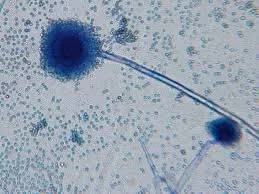Aspergillus flavus, most known for hanging around cursed mummies, is getting a chance to clean up its act. The fungus, thought to be behind the deaths of several archaeologists who came into contact with it after opening Tutankhamun’s tomb in 1922, now shows promise as a synthesizer of powerful cancer-killing molecules.
In a recent article published in Nature Chemical Biology, researchers describe a new class of fungal proteins with activity against human leukemia cells. The molecules were identified in A. flavus and belong to the RiPP category: ribosomally synthesized and post-translationally modified peptides. While bacterial RiPPs are a well-known and growing category of potentially therapeutic molecules, fungal RiPPs remain comparatively undercharacterized. This is in part, the authors say, due to the inaccuracy of earlier detection techniques, which misidentified many fungal RiPPs as non-ribosomal. Progress in fungal genome sequencing and bioinformatic analysis has helped to solve this problem.
The research team, led by scientists at the University of Pennsylvania, started with 12 species of Aspergillus after previous studies pointed to the genus as a promising source of new RiPPs. The team grew each of the fungi on ten different food sources, or media, because a fungus might only produce a specific molecule when given a particular diet. After letting them grow, the researchers collected the entire chemical "soup" of molecules produced by each fungus. Using a machine that sorts by weight, they sifted through thousands of compounds. A small group of molecules produced by A. flavus stood out; when these molecules were fragmented, the resulting pieces were identifiable amino acids, the fundamental building blocks of all proteins, including RiPPs. Bioinformatic predictions then indicated that a gene in A. flavus, called ApgA, was likely responsible for RiPP production. To test if the interesting molecules could be RiPPs encoded by ApgA, the team genetically edited A. flavus to remove this gene. Production of the molecules of interest stopped, confirming they were indeed RiPPs coded for by the ApgA gene.
With the molecules’ genetic origin confirmed, the researchers could begin to study the compounds in detail. They isolated four distinct versions, asperigimycins A-D, and revealed a complex molecular structure built around a core of seven interlocking rings. When the team tested the compounds against human cancer cells, they found that asperigimycins C and D were effective against several leukemia cell lines, while asperigimycins A and B were inactive. This difference in activity allowed the researchers to identify a molecular feature responsible for anticancer activity: the potent asperigimycins possessed a chemical modification, a pyroglutamate group, at their N-terminus, the peptide chain’s starting point.
Based on this finding, the team hypothesized that synthetically modifying the N-terminus of an inactive RiPP could render it active. They chose asperigimycin B, the most abundant inactive version, and chemically attached different fatty acid chains to its N-terminus. One of these new derivatives, called 2-L6, was over 100 times more potent than the naturally active asperigimycins and showed effectiveness comparable to existing leukemia drugs in lab tests. Interestingly, the molecule was also highly selective, killing several leukemia cell lines while leaving other cancer types, like cervical and liver cancer cells, unharmed.
The remarkable potency of 2-L6 raised a final question: what made it so effective? Using the genetic screening tool CRISPR, the team found the molecule's method of entry into a cell. 2-L6 is actively transported into cancer cells by another protein, SLC46A3, which explains its selectivity for certain cell types. Once inside, the drug delivers its lethal cytotoxic effect by inhibiting tubulin polymerization, a process which fatally disrupts the cell’s internal structure.
The scientists’ identification and optimization of asperigimycins represents a promising advancement in the field of cancer research. As both drug resistance and cancer incidence continue to increase, the need for new anticancer drugs, such as those derived from fungi, will only grow more important in the future.
References:
Kessler, S.C. and Chooi, Y.H. (2022) ‘Out for a RiPP: challenges and advances in genome mining of ribosomal peptides from fungi’, Natural product reports, 39(2): 222-230, available: https://doi.org/10.1039/d1np00048a.
Li, Y., et al. (2020) ‘The manifold roles of microbial ribosomal peptide-based natural products in physiology and ecology’, Journal of Biological Chemistry, 295(1): 34-54, available: https://doi.org/10.1074/jbc.REV119.006545.
Nie, Q., et al. (2025) ‘A class of benzofuranoindoline-bearing heptacyclic fungal RiPPs with anticancer activities’, Nature Chemical Biology, available: https://doi.org/10.1038/s41589-025-01946-9.

